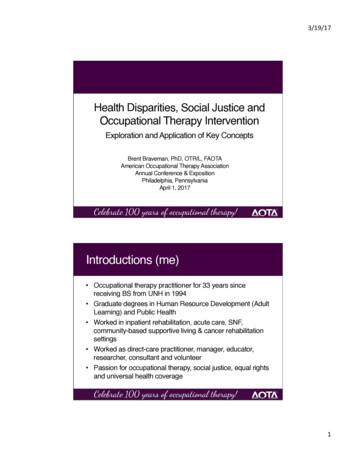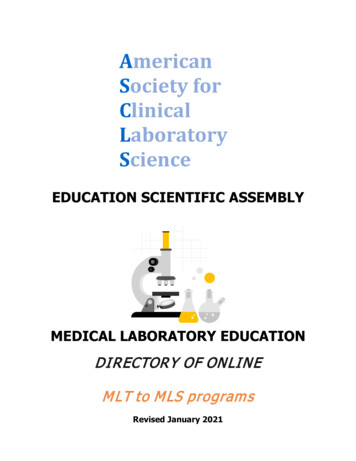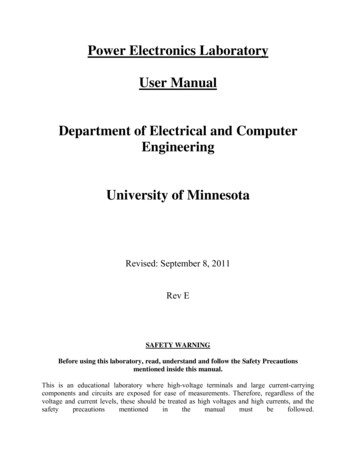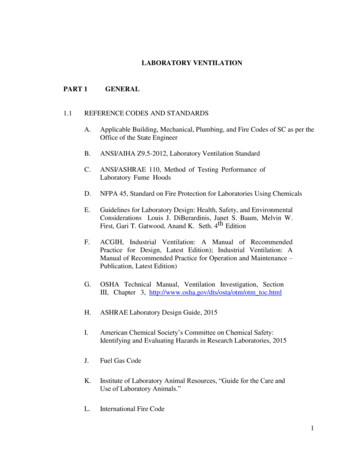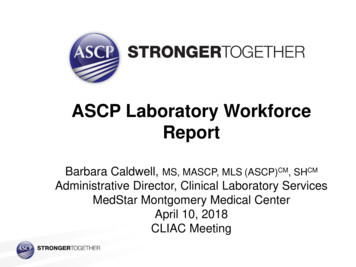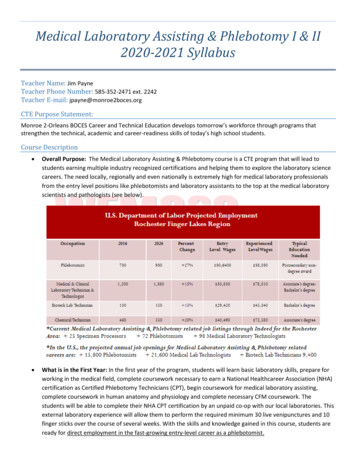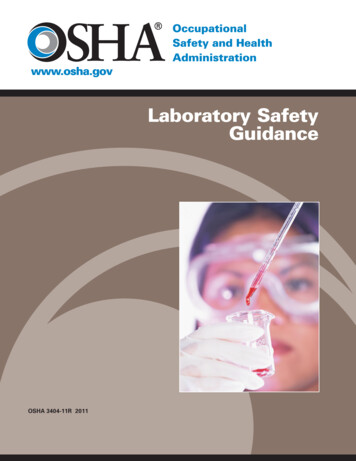
Transcription
Laboratory SafetyGuidanceOSHA 3404-11R 2011
Occupational Safety and Health Act of 1970“To assure safe and healthful working conditionsfor working men and women; by authorizing enforcement of the standards developed underthe Act; by assisting and encouraging the States intheir efforts to assure safe and healthful workingconditions; by providing for research, information,education, and training in the field of occupationalsafety and health.”This publication provides a general overview ofa particular standards-related topic. This publicationdoes not alter or determine compliance responsibilities which are set forth in OSHA standards, andthe Occupational Safety and Health Act of 1970.Moreover, because interpretations and enforcementpolicy may change over time, for additional guidance on OSHA compliance requirements, the readershould consult current administrative interpretations and decisions by the Occupational Safetyand Health Review Commission and the courts.Material contained in this publication is in the publicdomain and may be reproduced, fully or partially,without permission. Source credit is requestedbut not required.This information will be made available to sensoryimpaired individuals upon request. Voice phone:(202) 693-1999; teletypewriter (TTY) number: 1-877889-5627.
Laboratory SafetyGuidanceOccupational Safety and Health AdministrationU.S. Department of LaborOSHA 3404-11R2011
This guidance document is not a standard or regulation, and itcreates no new legal obligations. It contains recommendations aswell as descriptions of mandatory safety and health standards.The recommendations are advisory in nature, informational incontent, and are intended to assist employers in providing a safeand healthful workplace. The Occupational Safety and Health Actrequires employers to comply with safety and health standardsand regulations promulgated by OSHA or by a state with an OSHAapproved state plan. In addition, the Act’s General Duty Clause,Section 5(a)(1), requires employers to provide their employees witha workplace free from recognized hazards likely to cause death orserious physical harm.2Occupational Safety andHealth Administration
ContentsIntroduction4OSHA Standards5Autoclaves and Sterilizers24Hierarchy of Controls8Centrifuges24Chemical Hazards9Compressed Gases249Cryogens and Dry Ice25Electrical25Fire26Lockout/Tagout27Trips, Slips and Falls28Laboratory StandardHazard Communication Standard13Specific Chemical Hazards13Air Contaminants Standard13Formaldehyde Standard14Latex15Chemical Fume HoodsBiological Hazards1515Safety HazardsReferences29Appendices30Additional OSHA InformationBiological Agents (other than BloodbornePathogens) and Biological Toxins15Bloodborne Pathogens17Research Animals19Biological Safety Cabinets (BSCs)21Physical Hazards and Others21Ergonomic Hazards21Ionizing Radiation21Non-ionizing Radiation22Noise232430Other Governmental and Non-governmentalAgencies Involved in Laboratory Safety40Most Common Zoonotic Diseasesin Animal Workers45Complaints, Emergenciesand Further Assistance46OSHA Regional Offices48LABORATORYSAFETY3
IntroductionMore than 500,000 workers are employed in laboratories in the U.S. The laboratory environmentcan be a hazardous place to work. Laboratoryworkers are exposed to numerous potential hazardsincluding chemical, biological, physical and radioactive hazards, as well as musculoskeletal stresses.Laboratory safety is governed by numerous local,state and federal regulations. Over the years, OSHAhas promulgated rules and published guidance tomake laboratories increasingly safe for personnel.This document is intended for supervisors, principalinvestigators and managers who have the primaryresponsibility for maintaining laboratories undertheir supervision as safe, healthy places to workand for ensuring that applicable health, safetyand environmental regulations are followed.Worker guidance in the form of Fact Sheets andQuickCards is also provided for certain hazardsthat may be encountered in laboratories. There areseveral primary OSHA standards that apply tolaboratories and these are discussed below. Thereare also other OSHA standards that apply to various aspects of laboratory activities and these arereferred to in this document.The Occupational Exposure to Hazardous Chemicalsin Laboratories standard (29 CFR 1910.1450) wascreated specifically for non-production laboratories.Additional OSHA standards provide rules thatprotect workers, including those that who inlaboratories, from chemical hazards as wellas biological, physical and safety hazards. Forthose hazards that are not covered by a specificOSHA standard, OSHA often provides guidanceon protecting workers from these hazards. Thisdocument is designed to make employers awareof the OSHA standards as well as OSHA guidancethat is available to protect workers from the diversehazards encountered in laboratories. The extent ofdetail on specific hazards provided in this documentis dependent on the nature of each hazard andits importance in a laboratory setting. In additionto information on OSHA standards and guidancethat deal with laboratory hazards, appendices areprovided with information on other governmentaland non-governmental agencies that deal withvarious aspects of laboratory safety.This Laboratory Safety Guidance booklet dealsspecifically with laboratories within the jurisdiction ofFederal OSHA. There are twenty-five states and twoU.S. Territories (Puerto Rico and the Virgin Islands)that have their own OSHA-approved occupationalsafety and health standards, which may be differentfrom federal standards, but must be at least “aseffective as” the federal standards. Contact yourlocal or state OSHA office for further information.More information on OSHA-approved state plans isavailable at: www.osha.gov/dcsp/osp/index.html.4Occupational Safety andHealth Administration
OSHA StandardsSection 5(a)(1) of the Occupational Safety andHealth Act of 1970 (OSH Act), the General DutyClause, requires that employers “shall furnish toeach of his employees employment and a placeof employment which are free from recognizedhazards that are causing or likely to cause deathor serious physical harm to his employees.”Therefore, even if an OSHA standard has not beenpromulgated that deals with a specific hazard orhazardous operation, protection of workers fromall hazards or hazardous operations may be enforceable under section 5(a)(1) of the OSH Act. Forexample, best practices that are issued by non-regulatory organizations such as the National Institutefor Occupational Safety and Health (NIOSH), theCenters for Disease Control and Prevention (CDC),the National Research Council (NRC), and theNational Institutes of Health (NIH), can be enforceable under section 5(a)(1).The principal OSHA standards that apply to allnon-production laboratories are listed below.Although this is not a comprehensive list, it includes standards that cover the major hazards thatworkers are most likely to encounter in their dailytasks. Employers must be fully aware of thesestandards and must implement all aspects of thestandards that apply to specific laboratory workconditions in their facilities.The Occupational Exposure to Hazardous Chemicalsin Laboratories standard (29 CFR 1910.1450),commonly referred to as the Laboratory standard,requires that the employer designate a ChemicalHygiene Officer and have a written Chemical HygienePlan (CHP), and actively verify that it remainseffective. The CHP must include provisions for workertraining, chemical exposure monitoring whereappropriate, medical consultation when exposureoccurs, criteria for the use of personal protectiveequipment (PPE) and engineering controls, specialprecautions for particularly hazardous substances,and a requirement for a Chemical Hygiene Officerresponsible for implementation of the CHP. TheCHP must be tailored to reflect the specific chemicalhazards present in the laboratory where it is to beused. Laboratory personnel must receive trainingregarding the Laboratory standard, the CHP, andother laboratory safety practices, including exposuredetection, physical and health hazards associatedwith chemicals, and protective measures.The Hazard Communication standard (29 CFR1910.1200), sometimes called the HazCom standard, is a set of requirements first issued in 1983 byOSHA. The standard requires evaluating the potential hazards of chemicals, and communicating information concerning those hazards and appropriateprotective measures to employees. The standardincludes provisions for: developing and maintaininga written hazard communication program for theworkplace, including lists of hazardous chemicalspresent; labeling of containers of chemicals in theworkplace, as well as of containers of chemicalsbeing shipped to other workplaces; preparation anddistribution of material safety data sheets (MSDSs)to workers and downstream employers; and development and implementation of worker training programs regarding hazards of chemicals and protective measures. This OSHA standard requires manufacturers and importers of hazardous chemicals toprovide material safety data sheets to users of thechemicals describing potential hazards and otherinformation. They must also attach hazard warninglabels to containers of the chemicals. Employersmust make MSDSs available to workers. They mustalso train their workers in the hazards caused by thechemicals workers are exposed to and the appropriate protective measures that must be used whenhandling the chemicals.The Bloodborne Pathogens standard (29 CFR1910.1030), including changes mandated by theNeedlestick Safety and Prevention Act of 2001,re-quires employers to protect workers frominfection with human bloodborne pathogens inthe workplace. The standard covers all workerswith “reasonably anticipated” exposure to bloodor other potentially infectious materials (OPIM). Itrequires that information and training be providedbefore the worker begins work that may involveoccupational exposure to bloodborne pathogens,annually thereafter, and before a worker is offeredhepatitis B vaccination. The Bloodborne Pathogensstandard also requires advance information andtraining for all workers in research laboratorieswho handle human immunodeficiency virus(HIV) or hepatitis B virus (HBV). The standardwas issued as a performance standard, whichmeans that the employer must develop a writtenexposure control plan (ECP) to provide a safe andhealthy work environment, but is allowed someflexibility in accomplishing this goal. Among otherthings, the ECP requires employers to make anLABORATORYSAFETY5
exposure determination, establish procedures forevaluating incidents, and determine a schedulefor implementing the standard’s requirements,including engineering and work practice controls.The standard also requires employers to provideand pay for appropriate PPE for workers withoccupational exposures. Although this standard onlyapplies to bloodborne pathogens, the protectivemeasures in this standard (e.g., ECP, engineeringand work practice controls, administrative controls,PPE, housekeeping, training, post-exposure medicalfollow-up) are the same measures for effectivelycontrolling exposure to other biological agents.The Personal Protective Equipment (PPE) standard(29 CFR 1910.132) requires that employers provideand pay for PPE and ensure that it is used wherever“hazards of processes or environment, chemicalhazards, radiological hazards, or mechanical irritants are encountered in a manner capable of causing injury or impairment in the function of any partof the body through absorption, inhalation or physical contact.” [29 CFR 1910.132(a) and 1910.132(h)].In order to determine whether and what PPE isneeded, the employer must “assess the workplaceto determine if hazards are present, or are likely tobe present, which necessitate the use of [PPE],”29 CFR 1910.132(d)(1). Based on that assessment,the employer must select appropriate PPE (e.g.,protection for eyes, face, head, extremities; protective clothing; respiratory protection; shields andbarriers) that will protect the affected worker fromthe hazard, 29 CFR 1910.132 (d)(1)(i), communicateselection decisions to each affected worker, 29 CFR1910.132 (d)(1)(ii), and select PPE that properly fitseach affected employee, 29 CFR 1910.132(d)(1)(iii).Employers must provide training for workers whoare required to use PPE that addresses when andwhat PPE is necessary, how to wear and care forPPE properly, and the limitations of PPE, 29 CFR1910.132(f).The Eye and Face Protection standard (29 CFR1910.133) requires employers to ensure that eachaffected worker uses appropriate eye or face protection when exposed to eye or face hazards fromflying particles, molten metal, liquid chemicals,acids or caustic liquids, chemical gases or vapors,or potentially injurious light radiation, 29 CFR1910.133(a).The Respiratory Protection standard (29 CFR1910.134) requires that a respirator be provided toeach worker when such equipment is necessary toprotect the health of such individual. The employermust provide respirators that are appropriate andsuitable for the purpose intended, as described in29 CFR 1910.134(d)(1). The employer is responsiblefor establishing and maintaining a respiratory protection program, as required by 29 CFR 1910.134(c),that includes, but is not limited to, the following:selection of respirators for use in the workplace;medical evaluations of workers required to userespirators; fit testing for tight-fitting respirators;proper use of respirators during routine and emergency situations; procedures and schedules forcleaning, disinfecting, storing, inspecting, repairingand discarding of respirators; procedures to ensureadequate air quality, quantity, and flow of breathingair for atmosphere-supplying respirators; trainingof workers in respiratory hazards that they may beexposed to during routine and emergency situations; training of workers in the proper donning anddoffing of respirators, and any limitations on theiruse and maintenance; and regular evaluation of theeffectiveness of the program.The Hand Protection standard (29 CFR 1910.138),requires employers to select and ensure that workers use appropriate hand protection when theirhands are exposed to hazards such as those fromskin absorption of harmful substances; severe cutsor lacerations; severe abrasions; punctures; chemical burns; thermal burns; and harmful temperatureextremes, 29 CFR 1910.138(a). Further, employersmust base the selection of the appropriate handprotection on an evaluation of the performancecharacteristics of the hand protection relative to thetask(s) to be performed, conditions present, duration of use, and the hazards and potential hazardsidentified, 29 CFR 1910.138(b).The Control of Hazardous Energy standard (29CFR 1910.147), often called the “Lockout/Tagout”standard, establishes basic requirements for lockingand/or tagging out equipment while installation,maintenance, testing, repair, or constructionoperations are in progress. The primary purposeof the standard is to protect workers from theunexpected energization or startup of machinesor equipment, or release of stored energy. Theprocedures apply to the shutdown of all potentialenergy sources associated with machines orequipment, including pressures, flows of fluids andgases, electrical power, and radiation.In addition to the standards listed above, otherOSHA standards that pertain to electrical safety6Occupational Safety andHealth Administration
(29 CFR 1910 Subpart S-Electrical); fire safety(Portable Fire Extinguishers standard, 29 CFR1910.157); and slips, trips and falls (29 CFR 1910Subpart D – Walking-Working Surfaces, SubpartE -Means of Egress, and Subpart J - GeneralEnvironmental Controls) are discussed at pages25-28. These standards pertain to general industry,as well as laboratories. When laboratory workersare using large analyzers and other equipment,their potential exposure to electrical hazardsassociated with this equipment must be assessedby employers and appropriate precautions taken.Similarly, worker exposure to wet floors or spillsand clutter can lead to slips/trips/falls and otherpossible injuries and employers must assurethat these hazards are minimized. While largelaboratory fires are rare, there is the potential forsmall bench-top fires, especially in laboratoriesusing flammable solvents. It is the responsibilityof employers to implement appropriate protectivemeasures to assure the safety of workers.LABORATORYSAFETY7
Hierarchy of ControlsOccupational safety and health professionals usea framework called the “hierarchy of controls” toselect ways of dealing with workplace hazards. Thehierarchy of controls prioritizes intervention strategies based on the premise that the best way tocontrol a hazard is to systematically remove it fromthe workplace, rather than relying on workers toreduce their exposure. The types of measures thatmay be used to protect laboratory workers, prioritized from the most effective to least effective, are: engineering controls; administrative controls; work practices; and personal protective equipment (PPE).Most employers use a combination of control methods. Employers must evaluate their particular workplace to develop a plan for protecting their workersthat may combine both immediate actions as wellas longer term solutions. A description of each typeof control for non-production laboratories follows.Engineering controls are those that involve making changes to the work environment to reducework-related hazards. These types of controls arepreferred over all others because they make permanent changes that reduce exposure to hazardsand do not rely on worker behavior. By reducing ahazard in the workplace, engineering controls canbe the most cost-effective solutions for employersto implement.Examples include: Chemical Fume Hoods; and Biological Safety Cabinets (BSCs).Administrative controls are those that modifyworkers’ work schedules and tasks in ways thatminimize their exposure to workplace hazards.Examples include: Developing a Chemical Hygiene Plan; and Developing Standard Operating Procedures forchemical handling.Work practices are procedures for safe andproper work that are used to reduce the duration,frequency or intensity of exposure to a hazard.When defining safe work practice controls, it is agood idea for the employer to ask workers for theirsuggestions, since they have firsthand experiencewith the tasks as actually performed. Thesecontrols need to be understood and followed bymanagers, supervisors and workers.Examples include: No mouth pipetting; and Chemical substitution where feasible (e.g., selecting a less hazardous chemical for a specificprocedure).Personal Protective Equipment (PPE) is protectivegear needed to keep workers safe while performingtheir jobs. Examples of PPE include respirators (forexample, N95), face shields, goggles and disposable gloves. While engineering and administrativecontrols and proper work practices are consideredto be more effective in minimizing exposure tomany workplace hazards, the use of PPE is alsovery important in laboratory settings.It is important that PPE be: Selected based upon the hazard to the worker; Properly fitted and in some cases periodicallyrefitted (e.g., respirators); Conscientiously and properly worn; Regularly maintained and replaced in accordwith the manufacturer’s specifications;Properlyremoved and disposed of to avoid con tamination of self, others or the environment;and If reusable, properly removed, cleaned, disinfected and stored.The following sections of this document are organized based upon classes of hazards, i.e., chemical, biological, physical, safety and other hazards.The organization of these sections and/or subsections may differ somewhat. For instance, OSHA’sLaboratory standard is described in greater detailthan any other standard in this document. This isbecause this is the only standard that is specificto laboratories (i.e., non-production laboratories).In all other sections, only those specific aspectsof various standards that are considered mostrelevant to non-production laboratories are discussed. In sections of this document where thereare no specific OSHA standards that apply, guidance in the form of Fact Sheets or QuickCards may be provided.8Occupational Safety andHealth Administration
Chemical HazardsHazardous chemicals present physical and/orhealth threats to workers in clinical, industrial, andacademic laboratories. Laboratory chemicals include cancer-causing agents (carcinogens), toxins(e.g., those affecting the liver, kidney, and nervoussystem), irritants, corrosives, sensitizers, as well asagents that act on the blood system or damage thelungs, skin, eyes, or mucous membranes. OSHArules regulate exposures to approximately 400 substances.Laboratory Standard(29 CFR 1910.1450)In 1990, OSHA issued the Occupational Exposureto Hazardous Chemicals in Laboratories standard(29 CFR 1910.1450). Commonly known as theLaboratory standard, it was developed to addressworkplaces where relatively small quantities ofhazardous chemicals are used on a non-productionbasis. However, not all laboratories are covered bythe Laboratory standard. For example, most quality control laboratories are not covered under thestandard. These laboratories are usually adjunctsof production operations which typically performrepetitive procedures for the purpose of assuringreliability of a product or a process. On the otherhand, laboratories that conduct research and development and related analytical work are subjectto the requirements of the Laboratory standard,regardless of whether or not they are used only tosupport manufacturing.The purpose of the Laboratory standard is to ensure that workers in non-production laboratoriesare informed about the hazards of chemicals intheir workplace and are protected from chemicalexposures exceeding allowable levels [i.e., OSHApermissible exposure limits (PELs)] as specified inTable Z of the Air Contaminants standard (29 CFR1910.1000) and as specified in other substance-specific health standards. The Laboratory standardachieves this protection by establishing safe workpractices in laboratories to implement a ChemicalHygiene Plan (CHP).Scope and ApplicationThe Laboratory standard applies to all individualsengaged in laboratory use of hazardous chemicals.Work with hazardous chemicals outside of laboratories is covered by the Hazard Communicationstandard (29 CFR 1910.1200). Laboratory uses ofchemicals which provide no potential for exposure(e.g., chemically impregnated test media or prepared kits for pregnancy testing) are not covered bythe Laboratory standard.Formaldehyde is one of the most commonly usedhazardous chemicals in laboratories. The OSHAFormaldehyde standard (29 CFR 1910.1048) specifically deals with protecting workers from thehazards associated with exposure to this chemical. It should be noted that the scope of theFormaldehyde standard is not affected in mostcases by the Laboratory standard. The Laboratorystandard specifically does not apply to formaldehyde use in histology, pathology and human oranimal anatomy laboratories; however, if formaldehyde is used in other types of laboratories whichare covered by the Laboratory standard, the employer must comply with 29 CFR 1910.1450.Program DescriptionThe Laboratory standard consists of five major elements: Hazard identification; Chemical Hygiene Plan; Information and training; Exposure monitoring; and Medical consultation and examinations.Each laboratory covered by the Laboratory standardmust appoint a Chemical Hygiene Officer (CHO) todevelop and implement a Chemical Hygiene Plan.The CHO is responsible for duties such as monitoring processes, procuring chemicals, helping projectdirectors upgrade facilities, and advising administrators on improved chemical hygiene policies andpractices. A worker designated as the CHO must bequalified, by training or experience, to provide technical guidance in developing and implementing theprovisions of the CHP.Hazard IdentificationEach laboratory must identify which hazardouschemicals will be encountered by its workers. Allcontainers for chemicals must be clearly labeled.An employer must ensure that workers do not use,store, or allow any other person to use or store, anyhazardous substance in his or her laboratory if thecontainer does not meet the labeling requirementsoutlined in the Hazard Communication standard,LABORATORYSAFETY9
29 CFR 1910.1200(f)(4). Labels on chemical containers must not be removed or defaced.Material Safety Data Sheets (MSDSs) for chemicalsreceived by the laboratory must be supplied by themanufacturer, distributor, or importer and mustbe maintained and readily accessible to laboratoryworkers. MSDSs are written or printed materialsconcerning a hazardous chemical. Employers musthave an MSDS in the workplace for each hazardouschemical in use.MSDS sheets must contain:1. Name of the chemical;2. Manufacturer’s information;3. Hazardous ingredients/identity information;4. Physical/chemical characteristics;5. Fire and explosion hazard data;6. Reactivity data;7. Health hazard data;8. Precautions for safe handling and use; and9. Control measures.The United States is participating in the GlobalHarmonization System of Classifying and LabelingChemicals (GHS) process and is planning to adoptthe GHS in its Hazard Communication standard.The GHS process is designed to improve comprehensibility, and thus the effectiveness of the HazardCommunication standard (HCS), and help to further reduce illnesses and injuries. GHS is a systemthat defines and classifies the hazards of chemicalproducts, and communicates health and safetyinformation on labels and material safety datasheets (called Safety Data Sheets, or SDSs, in theGHS). The most significant changes to the HazardCommunication standard will include changing terminology: “hazard determination” to “hazard classification” (along with related terms) and “materialsafety data sheet” to “safety data sheet.” The goalis that the same set of rules for classifying hazards,and the same format and content for labels andsafety data sheets (SDS) will be adopted and usedaround the world. An international team of hazardcommunication experts developed GHS.The biggest visible impact of the GHS is the appearance of and information required for labels andSDSs. Labels will require signal words, pictograms,precautionary statements and appropriate hazardstatements. The GHS system covers all hazardouschemicals and may be adopted to cover chemicalsin the workplace, transport, consumer products,and pesticides. SDSs will follow a new 16-sectionformat, containing requirements similar to thoseidentified in the American National StandardsInstitute (ANSI) Z400 and International Organizationfor Standardization (ISO) 11014 standards.Information on GHS classification, labels and SDSsis available at: http://www.unece.org/ trans/danger/publi/ghs/ghs welcome e.html.Chemical Hygiene Plan (CHP)The purpose of the CHP is to provide guidelinesfor prudent practices and procedures for the use ofchemicals in the laboratory. The Laboratory standard requires that the CHP set forth procedures,equipment, PPE and work practices capable of protecting workers from the health hazards presentedby chemicals used in the laboratory.The following information must be included ineach CHP:Standard Operating Procedures (SOPs): Prudentlaboratory practices which must be followed whenworking with chemicals in a laboratory. These include general and laboratory-specific proceduresfor work with hazardous chemicals.Criteria for Exposure Control Measures: Criteriaused by the employer to determine and implementcontrol measures to reduce worker exposure tohazardous chemicals including engineering controls, the use of PPE and hygiene practices.Adequacy and Proper Functioning of Fume Hoodsand other Protective Equipment: Specific measuresthat must be taken to ensure proper and adequateperformance of protective equipment, such asfume hoods.Information and Training: The employer must provide information and training required to ensurethat workers are apprised of the hazards of chemicals in their work areas and related information.Requirement of Prior Approval of LaboratoryProcedures: The circumstances under which certainlaboratory procedures or activities require approvalfrom the employer or employer’s designee beforework is initiated.Medical Consultations and Examinations:Provisions for medical consultation and examination when exposure to a hazardous chemical has ormay have taken place.10Occupational Safety andHealth Administration
Chemical Hygiene Officer Designation: Identificationof the laboratory CHO and outline of his or her roleand responsibilities; and, where appropriate, establishment of a Chemical Hygiene Committee.Particularly Hazardous Substances: Outlines additional worker protections for work with particularlyhazardous substances. These include select carcinogens, reproductive toxins, and substances whichhave a high degree of acute toxicity.Information and TrainingLaboratory workers must be provided with information and training relevant to the hazards of thechemicals present in their laboratory. The trainingmust be provided at the time of initial assignmentto a laboratory and prior to assignments involvingnew exposure situations.The employer must inform workersabout the following: The content of the OSHA Laboratory standardand its appendices (the full text must be madeavailable);The location and availability of the ChemicalHygiene Plan;Permissible exposure limits (PELs) for OSHAregulated substances, or recommended exposure levels for other hazardous chemicals wherethere is no applicable standard;Signs and symptoms associated with exposureto hazardous chemicals in the laboratory; andThe location and availability of reference materials on the hazards, safe handling, storage anddispos
hazards present in the laboratory where it is to be used. Laboratory personnel must receive training regarding the Laboratory standard, the CHP, and other laboratory safety practices, including exposure detection, physical and health hazards associated with chemicals, and protective measu



